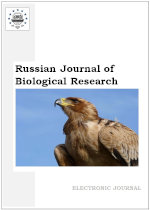1 December 25, 2023
Articles
1. Anton O. Manaenkov, Vladimir S. Bobrik
Determining the Level of Soil Contamination Using an Oat Bioindicator
Russian Journal of Biological Research. 2023. 10(1): 3-9.
Number of views: 75 Download in PDF
2. Mary Matawal Mankilik, Mhya H. Daniel, Ponjul WuyepRussian Journal of Biological Research. 2023. 10(1): 3-9.
Abstract:
The article presents the results of soil assessment using a bioindicator – germination of oats in room conditions. The task included sowing seeds and monitoring the dynamics of plant growth and development. The work of a team of two people (“B” and “A”) was carried out on the territory of the Industry Agricultural Business Incubator, as well as at the home of each team member. As a result of the research, the following was noted. The shoots were unfriendly. Phytotoxicity coefficients showed that the cleanest point chosen for sampling was calculated to be the dirtiest of all. The seeds that grew best were those planted in the soil from the first (dirtiest) point; they had 100 % germination. As a result of seed germination, data was obtained that indicated that oats, with due attention, can grow equally in different soil conditions, perhaps this is due to the unpretentiousness of this plant or the insufficient distance between soil sampling points.
The article presents the results of soil assessment using a bioindicator – germination of oats in room conditions. The task included sowing seeds and monitoring the dynamics of plant growth and development. The work of a team of two people (“B” and “A”) was carried out on the territory of the Industry Agricultural Business Incubator, as well as at the home of each team member. As a result of the research, the following was noted. The shoots were unfriendly. Phytotoxicity coefficients showed that the cleanest point chosen for sampling was calculated to be the dirtiest of all. The seeds that grew best were those planted in the soil from the first (dirtiest) point; they had 100 % germination. As a result of seed germination, data was obtained that indicated that oats, with due attention, can grow equally in different soil conditions, perhaps this is due to the unpretentiousness of this plant or the insufficient distance between soil sampling points.
Number of views: 75 Download in PDF
Evaluation of Antimalarial Activity of Methanolic Extract of Carica Papaya (Carecaccaea) Yellow Leaf in Mice
Russian Journal of Biological Research. 2023. 10(1): 10-16.
Number of views: 66 Download in PDF
3. Talip Şahin, Ömer Kılıç, Turgut TaşkınRussian Journal of Biological Research. 2023. 10(1): 10-16.
Abstract:
Malaria still remains a public health problem in developing countries. Malaria is one of the most prevalent diseases as people still rely on traditional medicine as source of treatment for this disease. Malaria causes mortality and morbidity with social economic impact in developing countries where the burden is high. Reports showed that the high global health challenges is partly due to multidrug resistance P. falciparum develop on existing and available antimalarial drugs and that has spur the search of alternate treatment with low or less side effect. The purpose of this study is to evaluate the antimalarial potential of methanolic extract of Carica papaya yellow leaf on animal model. In vivo screening for antimalarial drug discovery is of the recommended stream line process for new compound in path from drug discovery to developing. The Rane’s curative method of established infection was employed in vivo for assessing antimalarial activity. Swiss albino mice of both sexes weighing between 23-27 g and aged 6 weeks were infected with 1x10-7 P. berghei (NK-65) RBC/ml intraperitoneally and were treated with various dose (100, 200 and 400mg/lg bt.wt) of C. papaya yellow leaf methanolic extract. Acute oral toxicity test was employed using OECD method. The mice treated with 400 mg/kg b.wt of C. papaya yellow leaf extract showed significant (P < 0.05) antimalarial activity. In acute oral toxicity result showed that the maximum tolerated dose was found to be 5000 mg/kg body weight. C. papaya leaf extract showed antimalarial activity and study has validated its use by locals in the treatment of malaria in most developing countries. Recommendations are made for the isolation and identification of bioactive substance for possible drug development.
Malaria still remains a public health problem in developing countries. Malaria is one of the most prevalent diseases as people still rely on traditional medicine as source of treatment for this disease. Malaria causes mortality and morbidity with social economic impact in developing countries where the burden is high. Reports showed that the high global health challenges is partly due to multidrug resistance P. falciparum develop on existing and available antimalarial drugs and that has spur the search of alternate treatment with low or less side effect. The purpose of this study is to evaluate the antimalarial potential of methanolic extract of Carica papaya yellow leaf on animal model. In vivo screening for antimalarial drug discovery is of the recommended stream line process for new compound in path from drug discovery to developing. The Rane’s curative method of established infection was employed in vivo for assessing antimalarial activity. Swiss albino mice of both sexes weighing between 23-27 g and aged 6 weeks were infected with 1x10-7 P. berghei (NK-65) RBC/ml intraperitoneally and were treated with various dose (100, 200 and 400mg/lg bt.wt) of C. papaya yellow leaf methanolic extract. Acute oral toxicity test was employed using OECD method. The mice treated with 400 mg/kg b.wt of C. papaya yellow leaf extract showed significant (P < 0.05) antimalarial activity. In acute oral toxicity result showed that the maximum tolerated dose was found to be 5000 mg/kg body weight. C. papaya leaf extract showed antimalarial activity and study has validated its use by locals in the treatment of malaria in most developing countries. Recommendations are made for the isolation and identification of bioactive substance for possible drug development.
Number of views: 66 Download in PDF
Ethnobotanical and Bioactive Characteristics of some Sideritis L. Taxa and Major Essential Oil Compounds
Russian Journal of Biological Research. 2023. 10(1): 17-29.
Number of views: 79 Download in PDF
4. Talip Şahin, Ömer KılıçRussian Journal of Biological Research. 2023. 10(1): 17-29.
Abstract:
Turkey with a huge and rich variety of flora reserves lots of medical, aromatic and bioactive properties plants within its structure. In Turkey public medical science applications are encountered extensively and Turkey is one of the leading countries in the trade of medicinal and aromatic plants because of its geographical location, difference climate conditions, plant diversity and agricultural potential. As in whole world and in Turkey, use of plants existing in the natural flora for different purposes in traditional medicine; as spice, tea, insecticide, resin, veterinary cure, glue, essential oil, beverage, beekeeping, landscape and cosmetic industry. On the other hand, this important ethnobotanical knowledges are facing a danger of being lost by contemperary urbanisation and other negative factors. The local population has long utilized the taxa of the genus Sideritis L., as herbal tea and in traditional medicine. Most of Sideritis taxa have significant biological activity, the biological activities and traditional usage of the Sideritis taxa are far better understood in recent years but still needs attention. The majority of Sideritis taxa exhibit a variety of biological functions and are highly interesting for future research on their pharmacological characteristics and potential for pharmacy and medicine. In this study, it is aimed to review major essential oil compound, usage of traditional knowledge and biological activities of some Sideritis taxa in Turkey.
Turkey with a huge and rich variety of flora reserves lots of medical, aromatic and bioactive properties plants within its structure. In Turkey public medical science applications are encountered extensively and Turkey is one of the leading countries in the trade of medicinal and aromatic plants because of its geographical location, difference climate conditions, plant diversity and agricultural potential. As in whole world and in Turkey, use of plants existing in the natural flora for different purposes in traditional medicine; as spice, tea, insecticide, resin, veterinary cure, glue, essential oil, beverage, beekeeping, landscape and cosmetic industry. On the other hand, this important ethnobotanical knowledges are facing a danger of being lost by contemperary urbanisation and other negative factors. The local population has long utilized the taxa of the genus Sideritis L., as herbal tea and in traditional medicine. Most of Sideritis taxa have significant biological activity, the biological activities and traditional usage of the Sideritis taxa are far better understood in recent years but still needs attention. The majority of Sideritis taxa exhibit a variety of biological functions and are highly interesting for future research on their pharmacological characteristics and potential for pharmacy and medicine. In this study, it is aimed to review major essential oil compound, usage of traditional knowledge and biological activities of some Sideritis taxa in Turkey.
Number of views: 79 Download in PDF
Ethnobotanical Features and Pharmacological Studies of Some Nepeta L. Taxa
Russian Journal of Biological Research. 2023. 10(1): 30-39.
Number of views: 72 Download in PDF
5. Russian Journal of Biological Research. 2023. 10(1): 30-39.
Abstract:
Ethnobotany is a multidisciplinary science that studies plant-human relationship and tries to understand human interaction with plants. Ethnobotanical studies aim to record the information about plants that people have passed down from generation to generation for centuries. In recent years, developments in technology, migration from village to city, modern life, relative loss of traditions and customs cause the loss of orally transmitted information about plants. In this respect, ethnobotanical studies are valuable studies that will record “humanity's knowledge of plants”. The local population has long utilized from Nepeta taxa for different purposes. Most of Nepeta taxa have important pharmacological and biological activities and Nepeta taxa have many traditional usage. The majority of Nepeta taxa exhibit significant pharmacological characteristics and potential for pharmacy, cosmetic industry, medicine and etc. In this study, it is aimed to review ethnobotanical and pharmacological properties of some Nepeta taxa to contribute to studies on the subject.
Ethnobotany is a multidisciplinary science that studies plant-human relationship and tries to understand human interaction with plants. Ethnobotanical studies aim to record the information about plants that people have passed down from generation to generation for centuries. In recent years, developments in technology, migration from village to city, modern life, relative loss of traditions and customs cause the loss of orally transmitted information about plants. In this respect, ethnobotanical studies are valuable studies that will record “humanity's knowledge of plants”. The local population has long utilized from Nepeta taxa for different purposes. Most of Nepeta taxa have important pharmacological and biological activities and Nepeta taxa have many traditional usage. The majority of Nepeta taxa exhibit significant pharmacological characteristics and potential for pharmacy, cosmetic industry, medicine and etc. In this study, it is aimed to review ethnobotanical and pharmacological properties of some Nepeta taxa to contribute to studies on the subject.
Number of views: 72 Download in PDF








